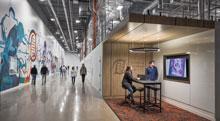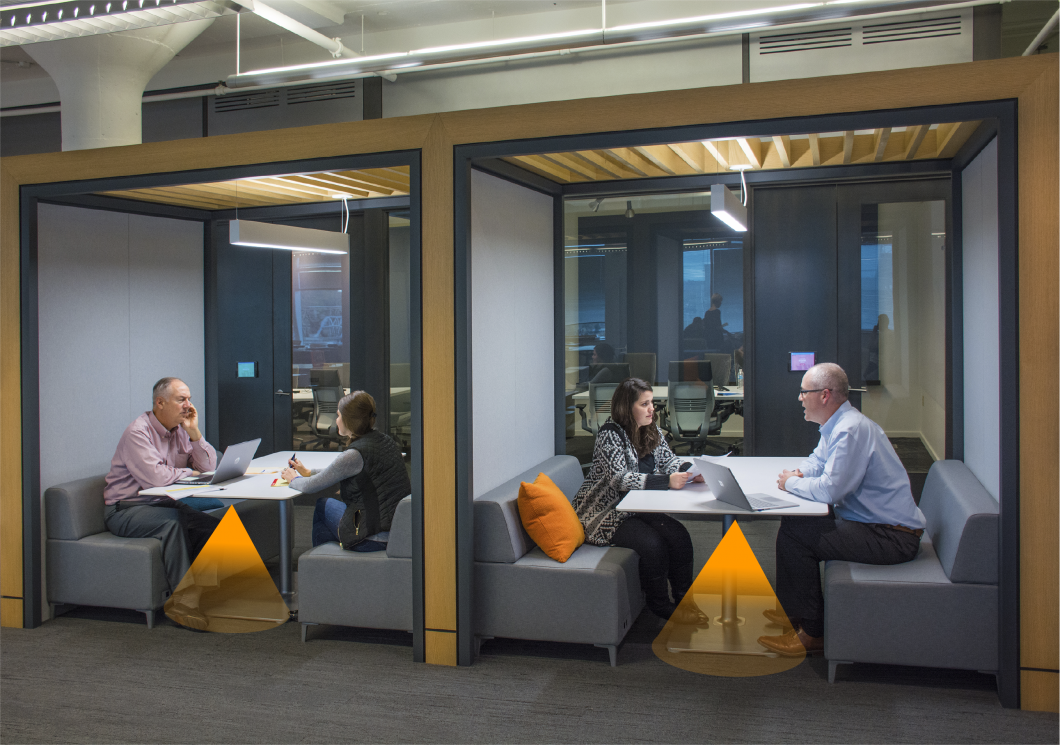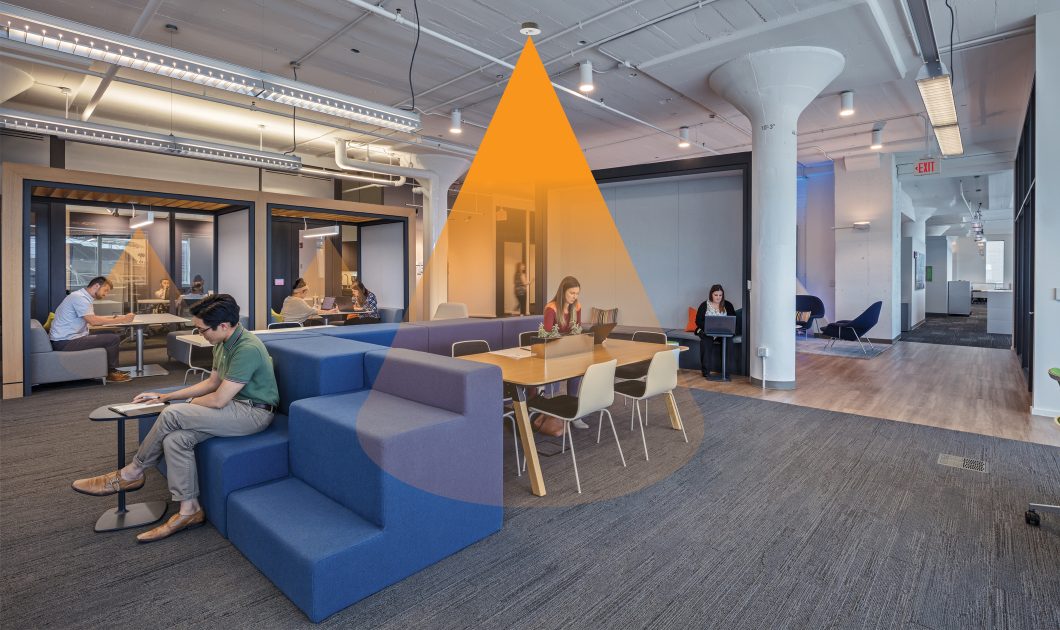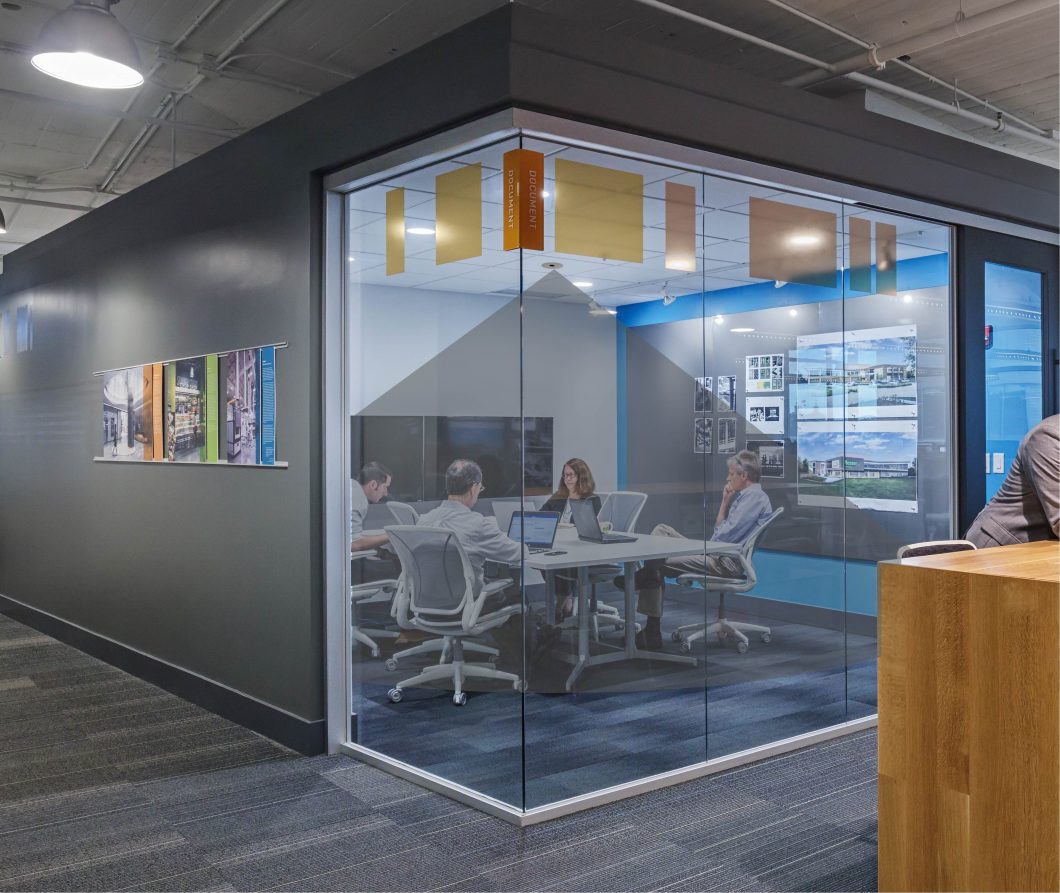
Making Sense of Sensors
By Dominic Iacobucci and Brad Johnson
A sensor is an electronic device that measures and captures data of variation in environmental stimulus. In today’s world, people encounter sensors throughout their day—at home, in the workplace, and at other locations. In a spatial workplace environment, sensors measure environmental aspects such as noise and light, while gathering information on when and how space is used. This data can be linked with technology solutions to enhance the experience and utilization of a space. As the use and availability of sensors increase, it is important to understand the advantages and disadvantages of using sensors in a spatial environment. Organizations that design and implement a comprehensive sensors strategy can ensure their facility space assets are leveraged to full potential.

Types of Workplace Sensors
There are many applications for using sensors in the workspace. Sensors can deliver information about sound, light, temperature, humidity levels, occupancy, and how people interact in the space. The most commonly used sensors for occupancy are motion sensors, which include passive infrared, pressure, vibration, and optical sensors that capture video motion. These can be deployed within the architecture of a room, attached or integrated into furniture, or placed within the floor. Occupancy sensing can occur using sound, lighting, temperature, and device recognition through Bluetooth or Wi-Fi signals.
Newer, advanced sensors use optical technologies that allow for artificial intelligence (AI), including image recognition and machine learning technology. Older sensors that collect information from only a single data source may not deliver a true understanding of how a workspace is used, whereas newer sensors offer more enhanced, comprehensive, and actionable data. For instance, an advanced sensor with AI can distinguish the quantity of employees using a set of desks, including environmental stimulus and levels of collaboration and focus. With a trend towards more activity-based workspace design, organizations are seeking data to understand how a workspace is being used and how enhance the user experience to drive results.

Using Workplace Sensors
Frequently, workplace sensors are used by the real estate sector. Real estate executives rely on utilization and occupancy data to manage and optimize their portfolios. The metrics provided by sensors help drive better informed real estate transactions due to accurate utilization and occupancy data that can be tracked to the minute. Beyond portfolio optimization, corporate real estate teams also use sensors for facility management and employee experience. The utilization and occupancy data provided by workspace sensors can enhance experience while driving sustainable practices through adjusting spatial qualities like lighting and temperature based upon occupancy.
Sensors also deliver accurate data on hotel desking, conference rooms, and activity setting availability and usage that interfaces real-time with interactive availability, booking, and reservation systems. And these systems can also unbook reserved spaces if occupancy is undetected after a set amount of time. Desktop browser systems and mobile apps provide access to several real-time data streams from sensors while allowing for individual interaction with reservation systems. For example, typically conference rooms are booked for a set amount of time. However, employees may vacate the room before their allotted time is over. A sensor in the conference room detects no occupancy and then sends a message to update the booking system to indicate that the room is available.
Additionally, building and workplace sensors support facility management through their connection to building management systems. Data and utilization from sensors can trigger notifications to a facility management team of potential maintenance requirements.
Today’s sensors also assist with the growing trend toward creating smart buildings. Some, however, consider the infrastructure and coverage required for some systems to be cost-prohibitive. This is especially true with existing buildings, if they require a retrofit of entire systems like HVAC to ensure proper communication between the building management system and the installed sensors. As the technology advances, newer buildings will be able to take advantage of integrating this automation.
One common concern with sensors is employee privacy and misuse of data. Whether or not employees are worried about being “tracked,” it is crucial that there are assurances from the organization that the data is collected anonymously and aggregated before it is released to management. Of even greater concern is data security, which requires organizations to have proper processes and controls in place, including data encryption, malware protection, and anonymization.

Designing a Sensor Solution
To maximize the use of sensors, facility space planners must understand the questions that the organization wants the data to help answer and then develop goals based on these questions.
A primary question for many organizations is whether their workspaces are well utilized. While sensors can measure occupancy to answer this question, the nuances and goals of the concern may be overlooked. Does the organization want to know the average occupancy of the space during any given hour, desk usage, or even conference efficiency? If the question is how often the room is used during a typical workday, the conference room efficiency based on number of employees using the room during a specified amount of time does not affect the answer. On the other hand, if the question is about the efficient use of the space, the number of employees using this workspace compared to the seats available is important.
These goals and questions impact the sensors used to measure space. Automated lighting sensors can measure if the space is in use, while infrared can measure the number of people around a table at seat locations. Optical sensors are needed to understand the quantity of people anywhere in the room and their work patterns. Organizations need to determine their own definitions of when workspaces are considered well-used assets. Depending on the goal, the answer may be when one employee uses a space designed for 10 or it may be when it is used by seven employees. Defining these questions and goals is crucial.
Equally important is the use of sensors to address the employee experience. Tools relying on sensor data, like mobile apps, provide employees the ability to find an available, suitable space quickly, increasing individual productivity and utilization of diverse spaces.
Achieving success requires evaluating the available sensors and selecting the ones that will provide the necessary data for desired insights. Understanding how real estate assets and workspaces are performing and being used gives organizations predictability. When implemented effectively, sensors can assist with workspace optimization, enhance user experience, and cut costs for the organization.
Article originally posted in Facility Executive.
